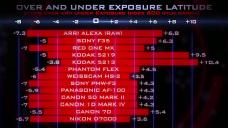
It allows to keep PV going, with more focus towards AI, but keeping be one of the few truly independent places.
-
That's correct, I measured Canon 5D in video mode at 9 max. in a scientific test.
-
from zacuto test : http://www.zacuto.com/the-great-camera-shootout-2011/episode-one

 vlcsnap-2012-01-20-07h56m08s68.jpg1920 x 1080 - 76K
vlcsnap-2012-01-20-07h56m08s68.jpg1920 x 1080 - 76K -
Pretty much accurate. The mushy image gives the appearance of something that is not there. The only Canon with anything to seriously offer is a 5D, and that's because of the ginormous sensor.
-
The problem with all these tests is that clipping is a very clear limit, no discussion about it. But the lower limit is debatable, since the image is increasingly getting drowned in noise, there is no obvious limit. The point where you are still ready to accept an image as such is subjective. Plus, the compression has a lot of influence on the perception of this. The only possibility is screening in blind tests to an experienced audience and have them rate the limit. Plus, you need a very good sample for this. I dare to challenge the usefulness of the circular sample they had for the zacuto test, I consider the Xyla-21 by DSC Labs superior (which we used). Our test is published in the current issue of Digital Production (Munich). DSLRs didn't play the major role, though, it was mainly about Alexa, Red and F3.
-
I dare to challenge the usefulness of the circular sample they had for the zacuto test
I thought that test to be absolutely useless for real life, usable dynamic range. Which I believe they had mentioned in the video - still they concluded DR from that, leading to those crazy DR numbers for canon DSLR video floating around the web.
-
On video coalition you have a set of test from back-lit chart from the 5d, red and Alexa. They did achieve more than 10 stops and depending on your appreciation of noise a 11 stop. Now that does not say the reality of true actual DR of the dslr. But this test have the merit of using the same methodology/system, so it also the same for the red and the Alexa. At least the result will be the same for all these camera between measured and perceived usable DR.
It is true that it is a little strange the result compared to the jpeg photo processing and the RAW DR of these cameras. One thing that could increase DR would be down-sampling. But the Canon supposedly do line skip so I don't have a clue.
-
The video above does not show anything in terms of DR. In not one scene you see a very contrasted lighting like an open window and the room inside. I am not saying that it is not nice but not good to test DR. As I shown in my test above, I do think that the gh2 is at least as good if not better than the Canon because of the shadow recovery with the high bitrate hack.
-
+1 nomad.
-
@ danyyel - Thanks for your tests. Loved reading them.
My point with that sample was that he was at ISO 2,000 and the dark areas of her hair, though still grainy, had detail that I doubt a 7D could render. Dynamic range "is" affected by ISO and I clearly remember my 7D turning to mush as I would hit 800 and beyond. Thats why DSLR users crush the shadows - these are not RedRaw or Arri Alexa cameras. Dynamic range and color is limited on all of them.
Also don't be fooled by the "bright room." While it has light, it was ISO 2000, he added optical flare, and he pulled the shadows to high key the video.
Now why the girl is on some strange planet (watch his other Canon 5D video - this artist has a lot of talent) is a mystery.
Anyway even if the 7D for some magical reason did have more dynamic range in low light it still can't:
- Handle motion as well as GH2 GOP1 hacks
- Resolve more detail
- Deal with moire
- Deal with aliasing
- Use 5 billion different lenses
- Plus GH2 costs half as much etc etc.
Ever shoot a close up of a models hair or clothing with a tight pattern with the 7D? No fun.
Anyway, everyone probably already knows all this stuff. Rambling...
Have fun everyone!
Howdy, Stranger!
It looks like you're new here. If you want to get involved, click one of these buttons!
Categories
- Topics List23,993
- Blog5,725
- General and News1,354
- Hacks and Patches1,153
- ↳ Top Settings33
- ↳ Beginners256
- ↳ Archives402
- ↳ Hacks News and Development56
- Cameras2,368
- ↳ Panasonic995
- ↳ Canon118
- ↳ Sony156
- ↳ Nikon96
- ↳ Pentax and Samsung70
- ↳ Olympus and Fujifilm102
- ↳ Compacts and Camcorders300
- ↳ Smartphones for video97
- ↳ Pro Video Cameras191
- ↳ BlackMagic and other raw cameras116
- Skill1,960
- ↳ Business and distribution66
- ↳ Preparation, scripts and legal38
- ↳ Art149
- ↳ Import, Convert, Exporting291
- ↳ Editors191
- ↳ Effects and stunts115
- ↳ Color grading197
- ↳ Sound and Music280
- ↳ Lighting96
- ↳ Software and storage tips266
- Gear5,420
- ↳ Filters, Adapters, Matte boxes344
- ↳ Lenses1,582
- ↳ Follow focus and gears93
- ↳ Sound499
- ↳ Lighting gear314
- ↳ Camera movement230
- ↳ Gimbals and copters302
- ↳ Rigs and related stuff273
- ↳ Power solutions83
- ↳ Monitors and viewfinders340
- ↳ Tripods and fluid heads139
- ↳ Storage286
- ↳ Computers and studio gear560
- ↳ VR and 3D248
- Showcase1,859
- Marketplace2,834
- Offtopic1,320




